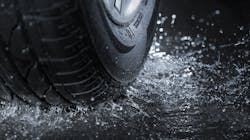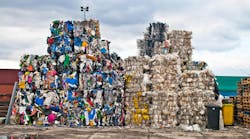Microplastics from tires contribute heavily to waterways pollution
A new study finds that tire wear particles were the most prevalent contributors to microplastics in urban stormwater runoff, according to a press release from Griffith University.
Published in Environmental Science & Technology, the study showed that in stormwater runoff during rain approximately 19 out of every 20 microplastics collected were tire wear particles with anywhere from 2 to 59 particles per liter of water.
“Pollution of our waterways by microplastics is an emerging environmental concern due to their persistence and accumulation in aquatic organisms and ecosystems,” said lead author Shima Ziajahromi, a research fellow at the Australian Rivers Institute. “Stormwater runoff, which contains a mixture of sediment, chemical, organic and physical pollutants, is a critical pathway for microplastics to washed off from urban environments during rain and into local aquatic habitats.”
Tire rubber contains up to 2500 chemicals, with the contaminants that leach from tires considered more toxic to bacteria and microalgae than other plastic polymers.
“Due to the analytical challenges in measuring this source of microplastics in stormwater, research to date often lacks information about the actual number of tire wear particles water samples,” said Ziajahromi.
Quantitative information of this type is crucial to improve understanding of the amount of tire wear particles in stormwater, assess the risk to the environment and to develop management strategies.
“Our study quantified and characterize microplastics and tire wear particles in both stormwater runoff and sediment of stormwater drainage systems in Queensland,” said co-author Fred Leusch, who leads the Australian Rivers Institute’s Toxicology Research Program. “We also assessed the effectiveness of a stormwater treatment device to capture and remove these contaminants from stormwater and evaluated the role of a constructed stormwater wetland for capturing microplastics in the sediment, removing it from stormwater runoff.”
“The device is a bag made of 0.2 millimetre mesh which can be retrofitted to stormwater drains,” said Leusch. “Although originally designed to capture gross pollutants, sediment, litter and oil and grease, it significantly reduced microplastics from raw runoff, with up to 88% less microplastics in treated water which had passed through the device.”
Sediment samples collected from the inlet and outlet of a constructed stormwater wetland contained between 1450 to 4740 particles in every kilogram of sediment, with more microplastics in the sediment at the inlet than the outlet, indicating the wetland’s ability to remove them from stormwater.


